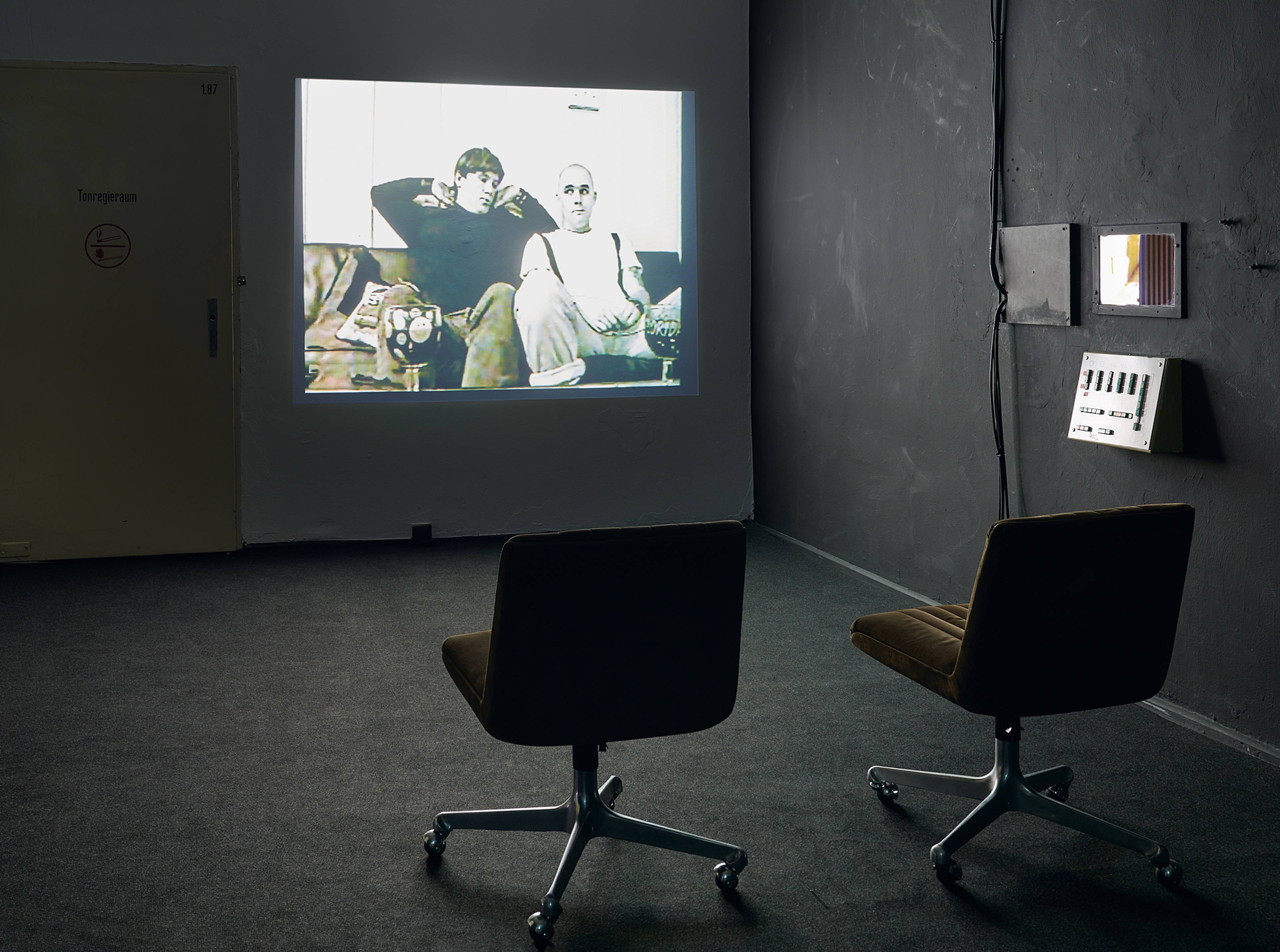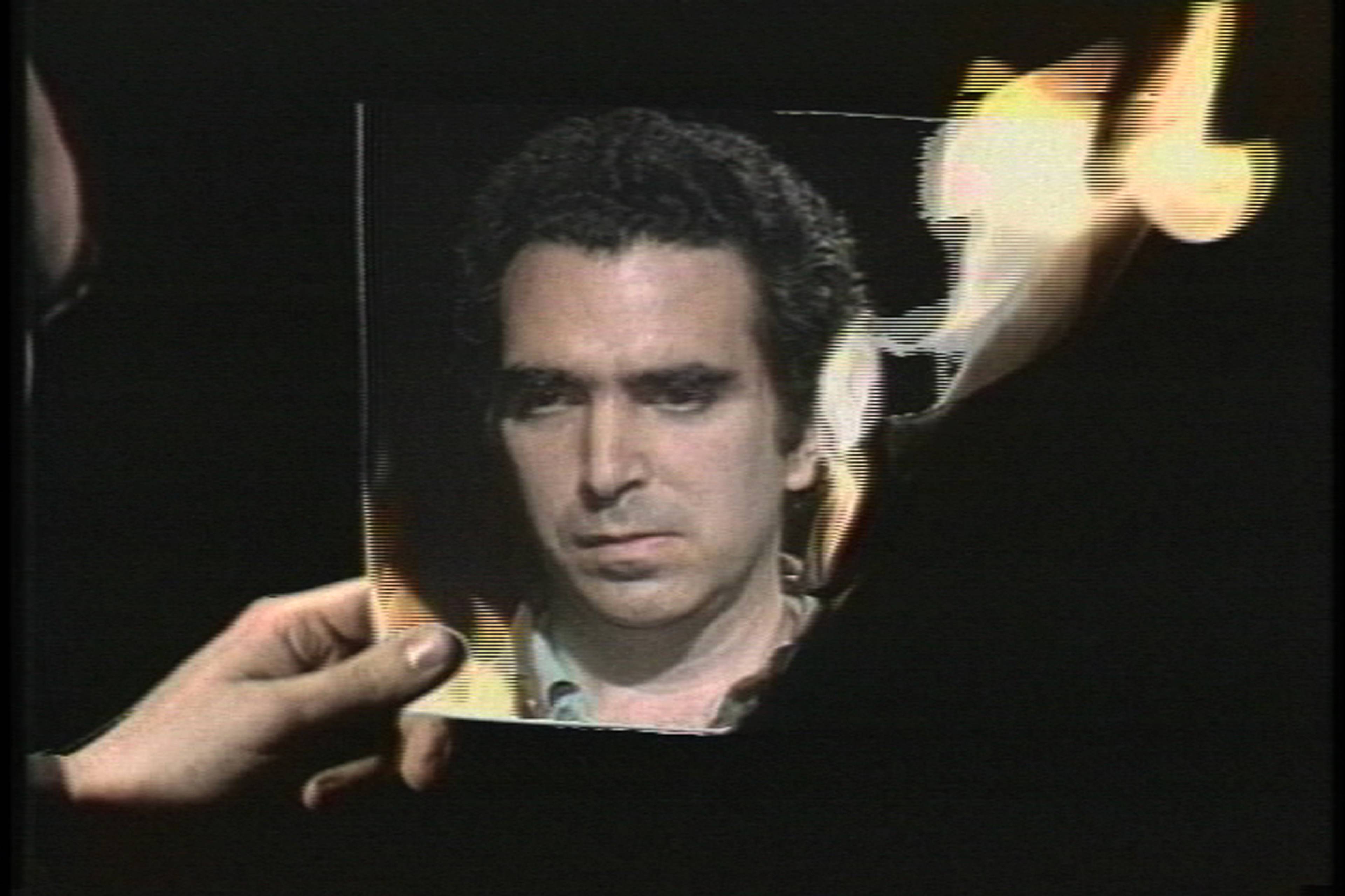“Unbound: Performance as Rupture” is a deep dive into the crossroads between performance art and video. The focus of the exhibition is to highlight how, at this junction, successive generations of artists working since the 1960s have used technological innovations to put ideas of identity into critical perspective. One of the main threads of this group show, on point, is a deferred conversation with other camera-based, mainstream, top-down media like cinema and television, as well as the political ideologies of representation they implicate. Who is the main character? Who is the sidekick? And what is the book of implicit rules and etiquettes that must be followed to be fronted as a subject of representation?
In The King (1972), Eleanor Antin dresses up in regal garb, poking at the naturalized idea that functions of authority and power are an exclusive male purview, echoing art historian Linda Nochlin and film theorist Laura Mulvey’s work exposing how gendered power imbalances inform the production and reception of visual culture. Ulysses Jenkins’s Mass of Images (1978), meanwhile, splices together stills from documented minstrel shows and D.W. Griffith’s Birth of a Nation (1915) to critique the Hollywood entertainment factory’s propagandizing of anti-Black stereotypes. VALIE EXPORT literalizes the relation between the female body and structures of domination in KÖRPERKONFIGURATION (BODY CONFIGURATION, 1982), a still photograph of her achingly encircling a column of Vienna’s Theseus Temple with her own figure.
Nao Bustamante, Rosa Does Joan, 1992, video, color, sound, 7:38 min. Installation views, JSF Berlin, 2023. All photos: Alwin Lay
VALIE EXPORT, KÖRPERKONFIGURATION, 1982, photograph, silver gelatin print, 119.5 x 180 cm
Eleanor Antin, The King, 1972, video, 52 min., b/w, no sound
An interesting intersection in the exhibition arises where the artists question their relations to the very machines they use to capture and reproduce audio and video. Lutz Mommartz treats his camera like a playful buddy, pointing it at the sky, a park, and even himself in Selbstschüsse (Selfshots, 1967), while in the exhilarating The White to be Angry (1999), Vaginal Davis recounts the homoerotic initiation of a neo-Nazi Angeleno skinhead. Her video appropriates film clips by directors like Woody Allen or Bruce LaBruce in a practice known as “zapping,” a bored yet hyper-stimulated jumping from channel to channel that accumulates discarded debris and fragments, forging new narrative pathways.
In Rosa does Joan (1992), queer Chicana artist Nao Bustamante appropriates the entire corporate apparatus of The Joan Rivers Show by posing as a “stunt exhibitionist,” conversely exposing the bold, prurient puritanism of the American comedian’s syndicated daytime broadcast. One of the exhibition’s centerpieces is Social Cohesiveness (2020), a grandiose mosaic of pictures and home-video footage from the family archive of Akeem Smith. The three-channel projection exuberantly documents the dancehall scene in Kingston from 1985 through the turn of the millennium, culminating in an interpolation of a gathering in the Jamaican capital on 11 September 2001 with images of the coeval attacks on New York’s World Trade Center.
Vaginal Davis, The White to be Angry, 1999. Installation view, JSF Berlin, 2023
Still from Vaginal Davis, The White to be Angry, 1999, digitized video, 19:22 min. b/w, sound. Courtesy: the artist and Galerie Isabella Bortolozzi, Berlin
Akeem Smith, Social Cohesiveness, 2020, three-channel video installation, color, sound, 32:53 min. Installation view, JSF Berlin, 2023
Precisely this work – partly due to its focus on the production of a community- first narrative – invites us to think about new perspectives that the exhibition points to but does not address, owing to its curatorial purpose (and leaving aside objective chronological reasons): that the shift in the use of filming technologies positioned at the center of “Unbound” has been paved by the changing economics of consumer-electronics industries. Since the 60s, it has become progressively cheaper and simpler for people to produce and distribute audio and video, dramatically changing the terms of how we experience art. We ourselves are currently assisting in the deepening of a new paradigm: The relative accessibility and functional omnipresence of personal portable devices has begotten a new mutation in the ways we refer to “performances,” which posit themselves not against cinema or TV, but as “experiential” situations to be documented (in timelines rather than archives). These “dance exhibitions,” as the critic Claire Bishop calls them, evolved at the convergence of experimental theater and the white cube, before finding purchase in museums’ need to attract new audiences amid the emergence of social media presentism.
One could also argue that the state of hyper-mediation most people with internet access live in has led to a new “performative turn,” in which the expressive domain becomes a subset of “content” production (I have heard the term used, informally and privately, by a couple of curators who work in North America to talk about annual programming at their respective institutions). The more or less professional production and monetization of events designed to be circulated is no longer solely the prerogative of artists, but a widespread condition. On the other hand, the “aura” of an artwork is tested relentlessly by the layout of social media timelines and the coding of promotional algorithms – that is, by the specific conditions of their reception near kittens, beaches, and countless advertisements. Intriguing evolutions of performance and video are likely to yield many further exhibitions in the coming years; for the time being, “Unbound” is an admirable survey in its linking of artistic practices to the material conditions of their production.
Still from mandla & Graham Clayton-Chance, as british as a watermelon, 2019, HD video, 28:30 min., color, sound. Courtesy: the artists
Panteha Abareshi, Unlearn the Body, 2021, Super 8 color negative film transferred to video, 4:55 min, color, sound
Still from Peter Campus, Three Transitions, 1973, video, 4:53 min., color, sound. Courtesy: the artist and Cristin Tierney, New York
___
“Unbound: Performance as Rupture”
Julia Stoschek Foundation, Berlin
14 Sep 2023 – 28 Jul 2024











